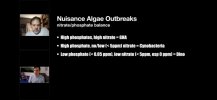I disagree. I know High Nutrients are still the 'hot item'... but i've ran tanks for years and years with nitrates below 0.25ppm and phophates below 0.05ppm. All tanks were mixed reefs including several acro and LPS colonies, and I never had any such issue. Additionally, I have yet to see a tank issue that was solved by increasing nutrients that ALSO didn't have a temperature, salinity, chemical, or other issue. It's quite common for me to see "my corals are dying because my nutrients are low... oh, and also my temperature is 91 degrees because my thermometer was broken." Lol. I know my opinion is in the minority, and I am open to new evidence. But here is what I see in your parameters.
Salinity (Very High importance): 1.023 is slightly outside of safe zone. But outside the safe zone is still 'outside'. So that is certainly a strong contributing factor.
Temp (Very High Imp.): Maybe no issue here. What were you using to get those measurements? Did you check it against a glass thermometer? (Not a lot of glass thermometers give decimals. Lol). This is a potential strong contributing factor.
Alk (High Imp.), it seems like you’re all over the place. Unstable parameters. It also seems like you went from 8.5 to 6.6 over 3 days, then back up to 7.1 dkH over 1 day. Either of these two occurrences has the possibility to wipe out most of your corals. Even if we ignore the middle 6.6 dkH as a false reading, going from 8.5 to 7.1 over 4 days still has the potential to kill corals. Too much change too quickly. Additional strong contributing factor.
pH (High Imp, but dont chase pH. it is expected to fluctuate hourly): No issue. Looks good.
Calcium (Moderate Imp. above safe limits): No issue. Looks good.
Mag (Moderate Imp): No issue. Looks good.
Nutrients (Moderate Imp. below safe limits, strong relationship with N): No issue. Looks good.
Chemiclean: This stuff works well, but is really stressful on corals. Usually they wont die from it, but it does cause stress... in addition to reducing oxygen levels. Additional strong contributing factor.
STN and RTN: These are contagious, in my limited experience with them. They spread from one colony to the next, no matter what. The ONLY solution that I have seen is complete removal. I recommend taking out the colonies, and drawing an imaginary line at least 1" from infected tissue. Everything within 1", consider it already infected. Move it to a different system if you want... but it will likely all die. But if you have branches >1" away, cut those frags, however tiny they may be. Those may be salvagable if the rest of the tank is completely clean. Additional strong contributing factor.
Corals are "Pale"... this sounds like too intense lighting and/or heat. Double check that thermometer, as previously mentioned. Otherwise, maybe your intensity increased either too much or too quickly when you switched to T5s. Tone down the lights. I've seen cornbred acros survive (but not thrive) for months in <50 PAR. Corals are more likely to die from too much light than too little. So err on the side of caution, decrease light, and build it up over time until you are happy. Additional strong contributing factor.
SUMMARY:
I see 5 Strong contributing factors, 1 potentially strong contributing factor, and 0 moderate contributing factors... in my experience. Like most things in life... disasters often dont happen because of 1 singular issue, but because of several factors coinciding. It appears the same here. Dont do too much, too quickly. Make very slow, methodical improvements, and log everything. I also recommend logging them consistently so that its a little easier to read and see changes/trends/patterns. Good luck!





